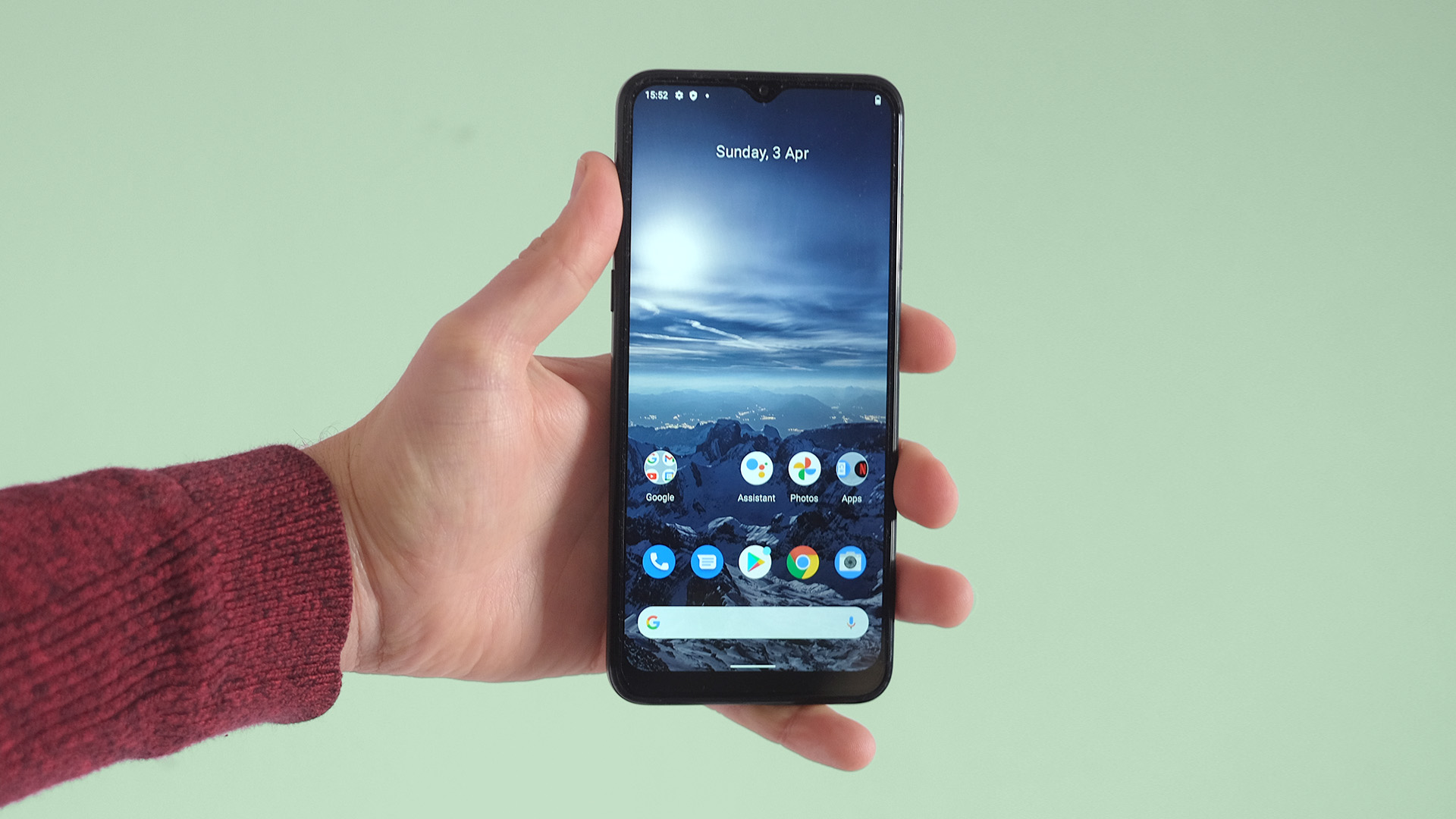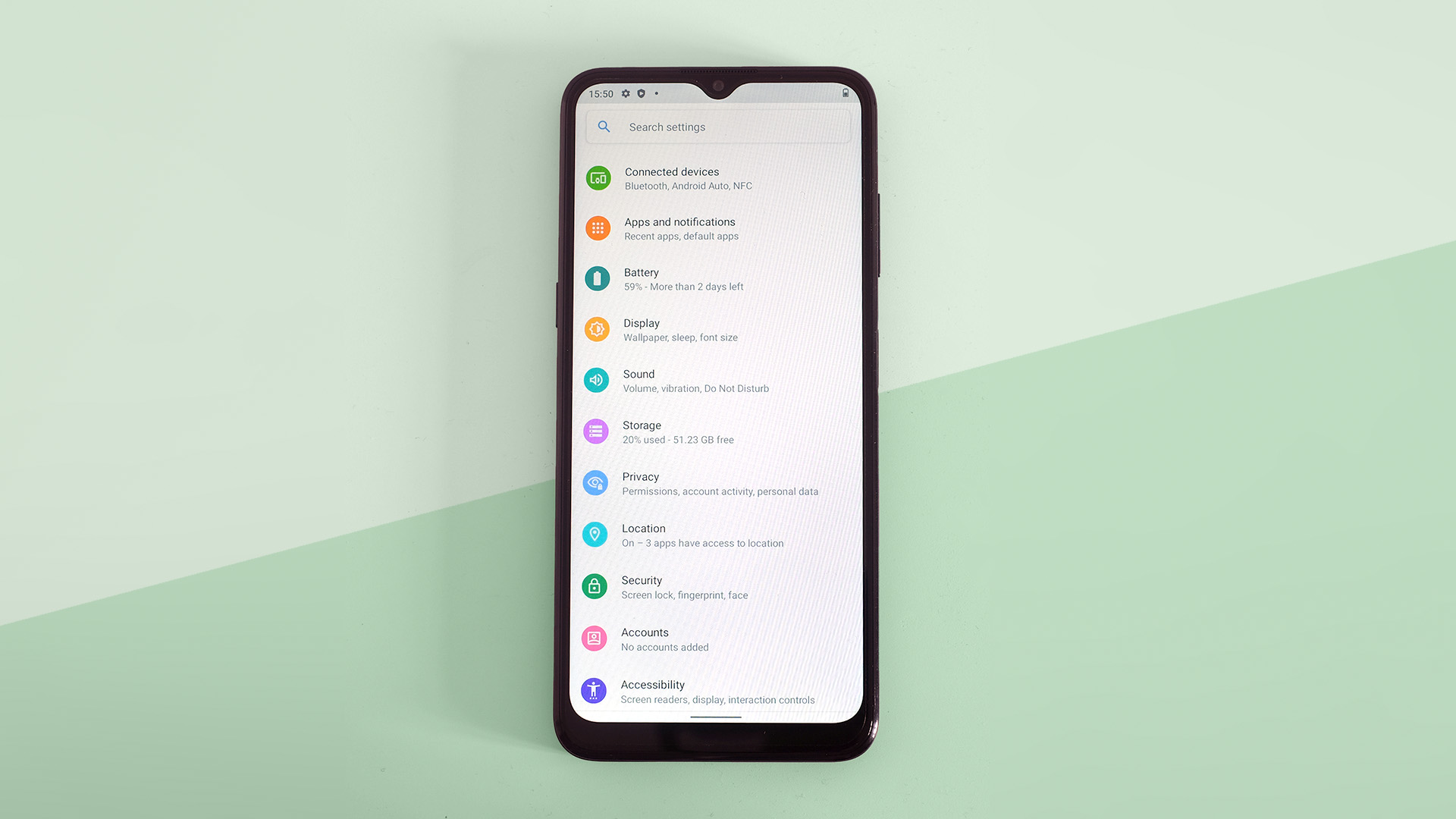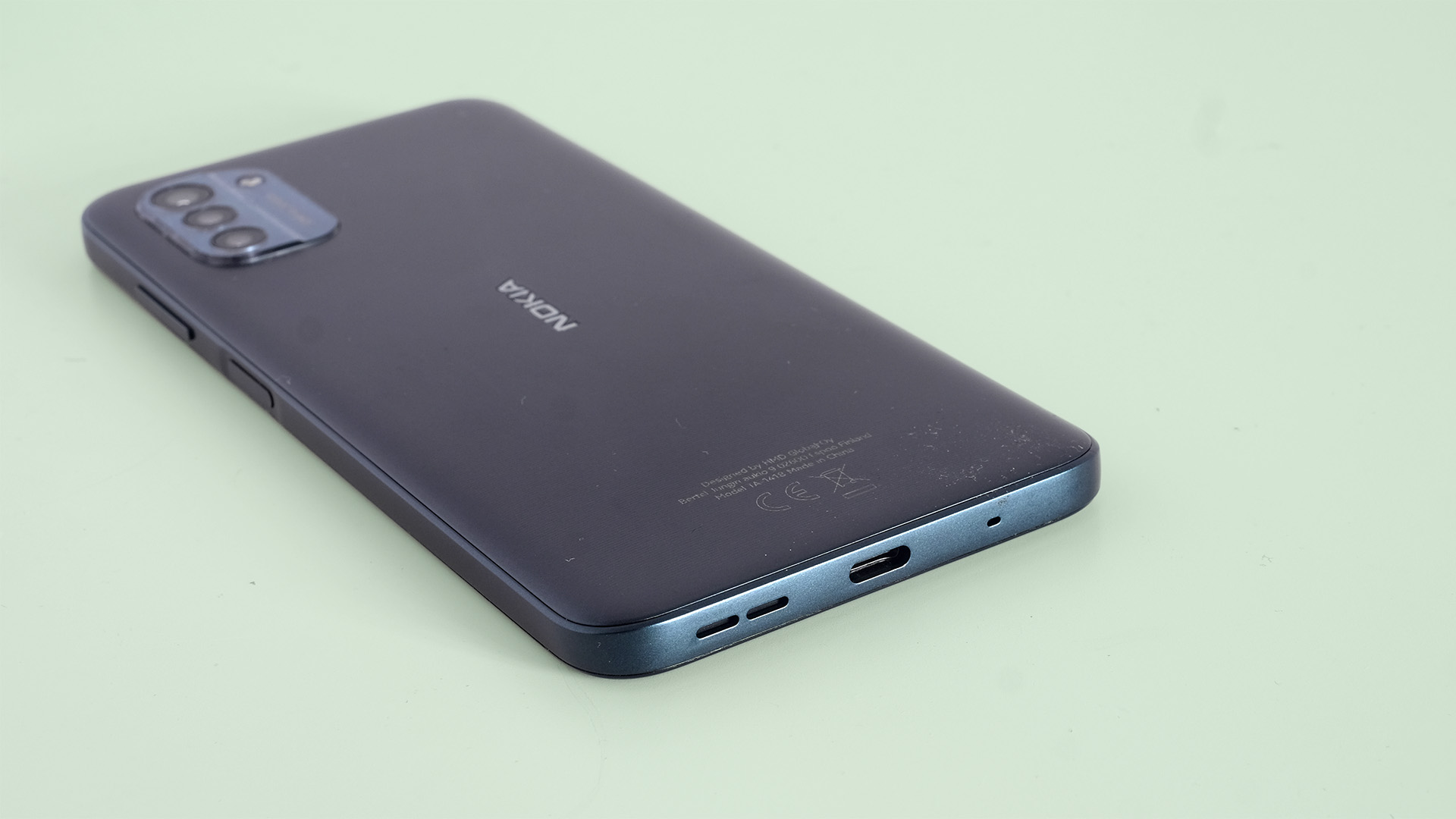Two-minute review
The Nokia G21 is an affordable 4G Android phone, the kind that may make a lot of sense if you want to buy SIM-free, putting an end to the days of paying big mobile bills each month.
We’re always game for this kind of Android, but the Nokia G21 isn’t one of the best. The screen is too dull to keep up with rival headsets. It’s something you’ll likely notice every time you use the phone outdoors.
Display color is slightly weak, too, although may not prove off-putting if you like a laidback appearance. The Nokia G21 also has an unusual Unisoc processor that means you miss out on 5G. Handling demanding games isn’t this phone’s forte, and in this regard the speaker doesn’t help either; it isn’t loud and it’s rather thin sounding.
The Nokia G21's camera could be worse. It takes passable shots in daylight, with images displaying decent enough colors. However, the rear camera is less interesting than it first appears, offering only one field of view, one 'zoom style', making the G21 feel more like a single-camera phone. Its predecessor, the Nokia G20, included an ultra-wide camera; this phone comes without.
Battery life is the one true Nokia G21 big-hitting feature. HMD Global (the company behind modern Nokia phones) says this handset can last up to three days from a single charge. Based on our experience, we’d say close to two days is a more realistic expectation to cling to. Nevertheless, that’s still pretty great.
Nokia G21 price and availability
- Out now in the UK and Australia
- Costs £149.99 / AU$299 (around $200)
The Nokia G21 was announced in February 2022, along with the even cheaper Nokia G11. The latter device is similar, but features a lower-end camera, and may be worth considering if you’re looking for a phone just for the basics.
For the G21, you can expect to pay £149.99 / AU$299 (roughly $200), but it's not currently available in the US.

Design
- Plastic casing with a grippy, ridged finish
- A pragmatic approach comes off well at this budget level
- Side-mounted fingerprint scanner
You’re never going to confuse a cheap phone like the Nokia G21 with a high-end one, but there’s a certain admirable honesty in Nokia’s entry-level designs.
The Nokia G21 has a lightly ridged plastic rear, one that does not try to pass itself off as glass or metal from a distance. There’s no light-reactive layer, so its appearance is fairly low-key. And the textured rear effect adds some grip.
In the previous generation device, Nokia opted for a round camera housing. The Nokia G21 comes with a more unassuming rounded rectangle that sits in one corner of the device.

You’re not getting anything too dynamic with the G21, but there are some features to note. The Nokia G21 has a teardrop notch rather than a punch-hole unit. Its side-mounted fingerprint scanner is reliable, and while a beat off the speed of a mid-range Android, it kind of matches the tempo of the phone in general.
Along the bottom edge of the Nokia G21 you’ll find a single speaker. It isn’t particularly loud; in fact, it sounds rather thin, and obviously delivers a poorer sound field than a stereo pair. Currently, you’re seeing budget devices include some pretty impressive speakers; the unit here is mediocre.
Display
- Limited peak brightness reduces outdoors visibility
- 90Hz refresh rate
- 720p resolution, lower than that of some rivals
The Nokia G21 has a 6.5-inch LCD screen, and on paper it’s exactly what we’d expect to see in a budget device. It’s a 720p panel, not the 1080p one you’d see included in a phone from a class up.
However, in 2022 even fairly cheap display panels can be remarkably good. Sadly, this isn’t the case here. The Nokia G21’s panel is below average, despite having a 90Hz refresh rate that makes menus appear to scroll more smoothly – when they’re not afflicted by mild UI judder, which happens fairly regularly.
The color depth is very much “sRGB”, lacking the vibrancy of OLED phones and even plenty of LCD-based units that cost just a little more. We don’t mind this less-saturated look at all – years of reviewing phones and their cameras tends to make you more sensitive to over saturation than the opposite – but you may feel differently.

Note, too, that the panel’s native color temperature is cool, leaning towards blueish whites. However, you can tweak this in the Settings menu. We think it looks better with the slider nudged over to “warm”.
However, it’s brightness that’s the Nokia G21’s major issue. On taking the phone outdoors to take some photos, we could barely see what was in the preview window. The phone just doesn’t offer the peak brightness required to deliver respectable clarity in high levels of ambient light.
To be fair to Nokia, it told us as much. The screen is rated for 400-nits of brightness, not the 600-plus seen in budget phones with high brightness modes that engage when there’s plenty of light. The 400-nits here is more what you’d expect from a decent laptop screen; it doesn’t cut it in a phone.
If you want a better display, look to Realme and Xiaomi phones. The Xiaomi Redmi 10 delivers superior colors, a higher resolution and better maximum brightness. However, you may need to spend slightly more to get the 600-plus nits of brightness that we think is the minimum for a truly versatile phone display.
Software and performance
- Tastefully plain interface
- Some basic navigational lag
- Poor gaming performance
The Nokia G21 runs Android 11, now the older version of the operating system. The newer Android 12 makes some neat surface-level changes – such as more color in the menu system – that would potentially enhance a phone such as this one.
Why might the Nokia G21 benefit, in particular? It runs an unusually clean version of the software. No superfluous apps, and no contentious additional interface elements.
This is classic Nokia, which has for years been the primary proponent of “naked Android” initiatives such as Android Go and Android One. A clean and clear interface is always welcome, although these days we find ourselves pretty happy using most manufacturers’ third-party skins.
Like other Nokia phones, you can choose to navigate the system using swipe gestures or classic soft keys.

The appeal of the Nokia G21’s clean software is dimmed a little by the phone’s performance. While not a laggy mess, there is noticeable judder in the interface at times, games take a little while to load, and you’ll notice the beat before more complicated websites populate. There’s often a lag of a few seconds when you bring the phone out of sleep, too.
This doesn’t ruin the overall experience of using a Nokia G21, but phones costing not much more have managed to make the real-world performance differences between cheap Android devices and more expensive models start to disappear.
The Nokia G21 has a slightly unusual Unisoc processor, the T606. This entry-level SoC is only used in cheap phones such as the Samsung Galaxy A03 and the step-down Nokia G11.
It scores 1165 in Geekbench 5, which is far lower than the ~1640 achievable in a phone featuring the Snapdragon 480. That’s one of Qualcomm’s entry-level 5G processors.
It’s this humble power, along with internal storage that can only read/write at speeds of around 120MB/second, which will cause slight slow-down when navigating through apps that haven’t been cached in the phone’s RAM. And since our model of Nokia G21 comes with only 4GB of RAM, it can’t afford to keep many processes in this kind of “fast recall” memory.

The Nokia G21’s performance is uninspiring stuff, but nothing out of line with our expectations of a handset at this end of the market.
You should consider its real-world impact on gaming, though. Fortnite wouldn’t install at all, listing the phone as unsupported, even though the 4GB of RAM should have meant the Nokia G21 met the minimum requirements.
Ark: Survival Evolved had a slideshow-like quality with the graphics maxed-out. To get it to a nicely smooth playable speed we had to set the graphics to “low” and bring down the resolution, making it look more like a PS2 game.
Gameloft’s Asphalt 9 ran much better. The frame rate wasn’t perfect, but it was completely playable at “high” graphics settings. We’ve seen theoretically more powerful phones run the game far worse, suggesting that either Gameloft has made some optimizations, or that the version of the game 720p phones run is less taxing than the one 1080p Androids get.
Cameras
- Limited fine detail and a soft character to images
- Good HDR for both normal shots and selfies
- Video is very bad
The camera is the main reason to buy the Nokia G21 over the Nokia G11. The phone comes with a 50-megapixel primary sensor, which seems to be this week’s hot resolution, seen in flagship phones such as the Samsung Galaxy S22.
The version of sensor here can’t compete with those included in high-end phones, of course. In classic Samsung fashion, the company takes what’s popular and has made a bargain-bucket version of it for the masses.
That said, the Nokia G21 offers sound camera performance for a near bottom-tier phone. Shoot in daylight and it captures photos with a slightly warm-leaning color temperature, solid HDR processing and color that, while perhaps a little “one note”, seems natural enough as a result of an almost complete lack of oversaturation.
Having often struggled to compose shots properly as a result of the Nokia G21’s dim screen, we were mostly pleased with the results.
However, what you shouldn’t expect is what the high-res sensor appears to promise: detail. The Nokia G21’s images don’t hold up as expected when zoomed-in. They’re a tad soft down at pixel level, and dense textures such as the leaves of distant trees just don’t look all that realistic up-close.
This is a classic example of what you get in a small pixel-binning sensor, designed to use several pixels of the sensor to create one in the final image. Matters don’t significantly improve when you use the 50-megapixel mode, either. Note, too, that we found the HDR mode a bit inconsistent.
Shoot the same scene a second apart and the Nokia G21 might leave highlights overexposed in one photo, only to correctly handle them in the next. It makes us wonder if the image processing stage is cut short or simplified when you shoot multiple images in succession, in order to avoid you having to wait for the camera to do its thing.

Night-time images are fairly poor; but we actually expected them to be worse given the Nokia G21’s small sensor. There’s a dedicated Night mode, which takes somewhere between one and two seconds to capture an image, with significant improvements to detail – both in the darkest areas, and to the sharpness of detail in the brighter parts.
We’re still miles off the quality of a great night-time shooter, but “mediocre” is better than “awful”.
We don’t recommend using the Nokia G2’s 2x zoom mode. This phone doesn’t have a zoom lens, and the poor close-up quality of standard pics is only emphasized when you digitally zoom into them.
So, if there’s no zoom, then what are the other two cameras on the back? There’s a poor 2-megapixel macro camera and a basic depth sensor for background-blurred portrait pictures.
Selfies are often surprisingly good, for the same reason that standard pics are: HDR. The Nokia G21 will have a good stab at managing the brightness level of images even if you shoot a selfie indoors with a background of a bright window. Fine detail isn’t remarkable – the software is the star – but it isn’t a bad result.
Video quality is awful, however. You can only shoot at resolutions up to 1080p, there’s no software stabilization at all, and the actual image looks more 360p resolution than 1080p.
Several ups and downs mean the Nokia G21 camera ends up being merely “OK”. If you don’t expect miracles from the tantalizing 50-megapixel sensor then you might come away satisfied – as long as you don’t plan to shoot video.
Camera samples








Battery life
- Battery life is great, suitable for charging every other day
- Charging is slow using the bundled charger
- Supports up to 18W charging
The Nokia G21 has a high-capacity 5,050mAh battery that Nokia claims can last up to three days between charges. Given two-day use is the typical optimistic claim we hear, this is a big one.
Most people are unlikely to see that kind of longevity, but real-world stamina remains excellent. Charging every other day is a realistic proposition with a Nokia G21, even if you use it for frequent messaging and photo-taking.
Thirty minutes of high-end gaming consumes 7% off the battery, suggesting that a full charge will last you a little over seven hours. Again, this is excellent.
The Nokia G21’s charging speed is a let-down, however. While the phone supports respectable 18W charging, the phone includes a slow 10W charger. This is going to take the best part of three hours to recharge the phone. That’s fine for overnight charging, but quick top-ups won’t be possible unless you get hold of a more powerful charger.
Should you buy the Nokia G21?

Buy it if...
Don't buy it if...
First reviewed: April 2022
via Tech Trade
Comments
Post a Comment